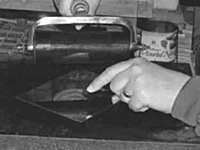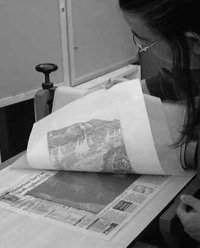
About Etchings - Not just a Print


Jan’s artworks are conceived as etchings. At no stage is there a finished drawing or painting from which the design (a word Jan uses to describe the initial conception of the image) is taken. Indeed, Jan often starts an etching with half a dozen lines on a sheet of blank paper. Jan deliberately likes to build up the image as she goes along on the copper plates using the ways the acid works on the metal to create some of the nuances of the image. Because Jan’s etchings are created in this way, they are called original prints and have nothing to do with prints that have been reproduced mechanically like photocopies or Glicée prints etc. Etchings can only be prints and are usually produced in a limited edition as the plates are extremely intensive to make often taking over 100 hours.
Brief History of Etching
Etching was created hundreds of years ago and originally used to decorate metal objects, the best known of these examples being weapons. Around the 17th century, etching was adapted as a form of printing. Rembrants etchings are well known for being reworked again and again and there are several of his images which exist today in different states. Jan does pretty much the same today, with only the use of aquatint being added at the end of the 19th century in France.
How we create Etchings

After selecting and designing the image, Jan takes a polished copper plate into which the etching will be created and places it on a hot-plate. This has some wax spread thinly over the plate with the help of the heat and is then smoked with tapers to smooth and darken the ground for working on. The waxes spread onto the plate can be known as “Hard Ground” or “Soft Ground”. For fine line-work Jan uses hard ground; soft ground is used in different ways to impress textures through the wax.
The image is drawn into the plate with a needle-like tool which removes the wax from the plate. Once all the work has been done for that stage of that plate, the unground areas of the plate are covered and the plate immersed in a bath of acid until the lines have been bitten to the correct depth.
This action is called the “etch”.
The procedure is then usually (but not always) repeated for the second plate; sometimes things besides the needle like tool can be used to make different marks.
After the line work on the “Hard Ground” stage on the plate has been completed, Jan uses an aquatint ground to create the part of the image which will give the broad areas of colour. A resin dust called an aquatint is sprinkled over the plate and adhered by heat. This is then “blocked out” usually using a size “0” brush with an acid resist liquid; this has to be done in stages as the depth of the bite created in this way gives the different strengths of colour. The plate is bitten in the acid bath for each stage and then reworked. Sometimes Jan will use a soft or open bite to further the techniques involved in each plate.

Between the states on the plates, the plates are proofed so Jan can determine what and how much needs to be done to complete the plate. Once the image is finished, the edges of the plate are bevelled with a metal file and from then on all the prints have the distinctive plate marks which all intaglio prints have.
Intaglio prints are ones which have image below the surface of the plate. These can be etchings or engravings where a tool known as a burin is literally pushed through the surface of the plate to take away the metal; other intaglio prints include mezzotints and drypoints.
Jan uses 2 plates for each image and now they are now ready for trial proofing – the final stage where the colours are resolved and the final image comes to life. When the final image has been resolved the edition size is determined. Copper is a soft metal which does limit the size of the edition which can be achieved. Once the edition is printed the plates are destroyed. As an artist, Jan never prints more than the edition size plus the traditional “Artists Proofs” of 10% and whilst she might make a series of similar images Jan feels she would not be an artist if she were to repeat an image.
Please remember, etchings are very fine works of art that cannot be fully reproduced in any medium
All images Copyright Jan Dingle. All rights reserved.